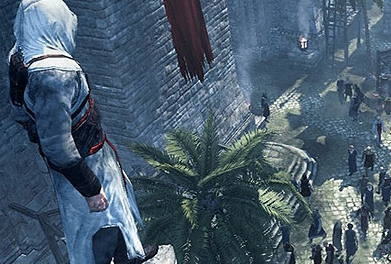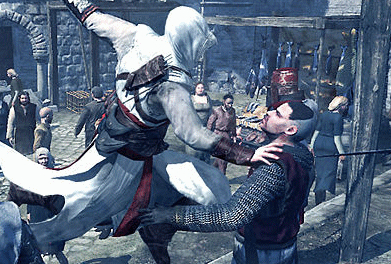 Review: Assassin’s Creed
Review: Assassin’s Creed

Action/Adventure/Third Person
Ubisoft’s medieval sleath-’em-up fails to stand out from the crowd.
![]()
Rich
When Assassin’s Creed switched from being a PS3 exclusive title to a multi-format one, 360 owners were understandably smug about their choice of console. A few screenshots, soundbites and an exceptionally atmospheric trailer later and this game was stealing column inches from such heavy-hitters as Halo3, Call Of Duty 4 and Bioshock and looking like an early contender for Game Of The Year.
However, there were warning signs. A marketing campaign focussed not on the game but on the relatively attractive Jade Raymond (well… in the sense that she looks like an petrified All-Saint) and a second trailer that seemed to highlight some particularly backwards AI soon left gamers feeling like this second coming of Christ was in fact going to be the second coming of Splinter Cell: Double Agent.

After a while the repetition starts to get to Altaïr...
The game, by way of a slightly clumsy ancestral-projection plot, puts you in the slippers of Altaïr, an elite assassin working in and around Jerusalem in 1191 during the Third Crusade of the Holy Land. After a botched mission, the Hashshashin leader Al Mualim demotes Altaïr who then spends the rest of the game getting himself back into his boss’ goodbooks by killing unscrupulous men who are exploiting the unstable situation for their own gains.
Even at this early stage the game drops a massive clanger. Not only is Altaïr stripped of all his weapons (fair enough) but he also loses several abilities such as catching ledges or being able to counter-attack. They don’t even bother explaining it away either but you’ll soon be able to earn these abilities back which makes the whole sorry episode a little less irritating.
Each level of the game is based around a particular hit, usually someone trading in human misery whilst having a selection of guards to hide behind. In order to get to know the target and their weaknesses, Altaïr first needs to spend some time investigating the city they are in usually by eavesdropping on conversations between henchmen or extracting information by getting shouty with his fists.

Ubisoft's idea of stealth.
In order to find these potential sources of intelligence, Altaïr has to scale the highest points of each city in order to map out sections of the local area. This process provides the game’s one true highlight. After sneaking past a guard and climbing up a tower (thanks to Altaïr’s considerable free-running skills) a quick press of the Y button will send the camera sweeping around a sneaky looking Altaïr, giving startlingly beautiful views of the surrounding area.
Once that section of the map is filled in, you can then take a nosedive into the nearest bale of hay and continue your quest. It’s not too realistic, and it’s a task you’ll have to perform dozens of times, but it doesn’t get old too quickly either.
Unlike the rest of the game.
For example, when you fill in these sections of maps it leads you towards what other reviewers laughably call sidequests. A sidequest generally involves seeing a civilian being tormented by guards who then turn their attention towards you with the invariable result of Altaïr standing over a pile of their corpses. Mildly entertaining the first time, utterly tedious after the twentieth.
The combat itself is also another example of style over substance. Whilst Altaïr’s counter-kills are spectacularly gory, the process of pulling them off involves merely holding the Right Trigger and pressing X. It requires next to no skill and is ultimately effective meaning that you can confidently run into groups of a dozen guards and mow them down like members of the Crazy 88.
Unlike something like Splinter Cell (also developed by Ubisoft Montreal) you really aren’t punished for going toe-to-toe with your enemies. The option to stealth-kill is there but the consequences of not using it are minimal especially as you can out-run any vengeful guards simply by holding Right Trigger, A and heading for the nearest rooftop.
|
Colin Secondary Review It’s a pretty game… I think. I bought Assassins Creed the day I bought a new HDTV – so I’m still fiddling with the settings. So let us just assume that it’s a pretty good looking game. OK. What else can we say that’s vaguely positive…? No? One of my biggest gripes about the game is not the lazy combat (lets see how well that ‘one button combat’ in Fable 2 works out), not the easy stealth kills (Tenchu – x360 proved that was a lot of fun) not the ludicrous Virtual Reality story thing (the Matrix anyone?) but rather the Free Running (apparently not the same as parkour, that’s for the artsy lads). Just holding a button and pointing in a direction is no fun at all. Jumping from building to building, jumping in different directions to grab ledges and even just jumping over randoms in the street is not a difficult thing to do in every other game. So why take it out then? I think Ubisoft doesn’t think much of the intelligence of the average gamer this is aimed at, and quite rightly so because the ‘average gamer’ is lapping this up. I don’t know what anyone sees in this game. Thank God I didn’t whore out for the Special Edition. Still, at least that Jade Raymond’s a hottie, eh? Secondary Score: 3/10 |
Even compared to the worst games in the Tenchu series, the guard placement and AI shows absolutely no thought at all. In one part of the game I was meant to eavesdrop on a target in a small area with one guarded entrance. There was no reason to try and trick my way past them as, even after a short but bloody battle, the nearby target was still happy to have their conversation.
The main hits take a fraction more thought to pull off, although only if you are going for a perfect hit for the achievement, but are ridiculously easy. I’m not asking for Hitman levels of planning here but a little bit of strategy would be nice. As a consequence, all the hits feel the same. Both in the investigation stage and the execution. Enter a new area, scale the high points, eavesdrop a couple of people, rescue a few civilians, go to identical looking Assassin HQ’s and then kill the boss. Reasonably fun once, not so tasty the second time around. After that it just seems like Ubisoft are taking the piss.
Tenchu and Hitman aren’t the only games that Assassin’s Creed suffers in comparison to either. Visuals aside, the free-running just isn’t as enjoyable as it was in Crackdown whilst the assassinations, investigations and combat lacks the depth of Oblivion. Instead you are left with a watered down mash of all these games with no one aspect being strong enough to stand in its own right.
For anyone desperate to try this one out for themselves expect a wave of pre-owned copies to hit your local store and don’t pay more than £25 for it. I recommend playing it in small, infrequent doses so that the repetitive gameplay will take longer to grate on you.
Of course, Ubisoft aren’t shy about making sequels so I’d expect a tighter, more varied experience for the inevitable Assassin’s Creed 2 but it’ll take a lot more than Jade Raymond and an UNKLE song to convince wary gamers to buy into the hype for a second time.
Rating: 








 5/10
5/10
